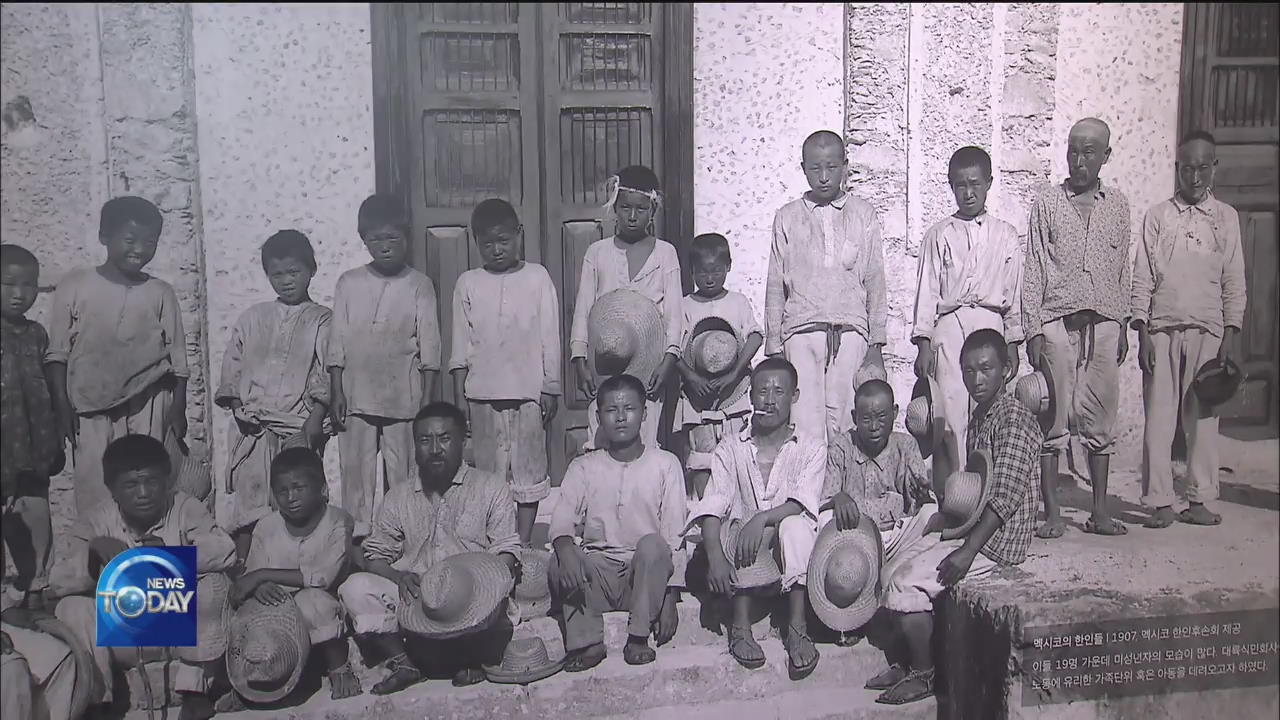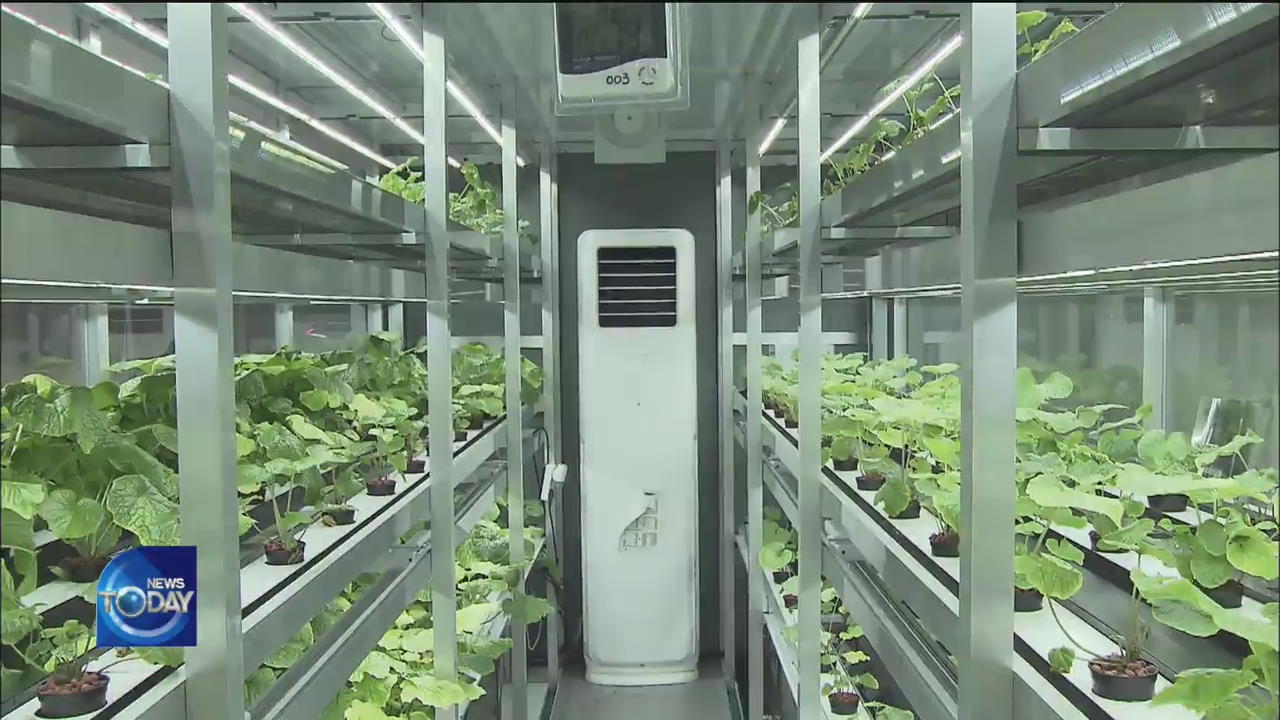EXHIBITION ON PAST KOREAN IMMIGRANTS
입력 2019.11.27 (15:06)
수정 2019.11.27 (16:46)
읽어주기 기능은 크롬기반의
브라우저에서만 사용하실 수 있습니다.
[Anchor Lead]
More than a century ago, Mexico was the second country of choice after Hawaii among Koreans emigrating overseas. A special exhibition has opened in Incheon to shed light on the difficult lives of Koreans who worked at henequen farms in Mexico and the meaning of the independence movement against Japanese colonial rule.
[Pkg]
Dolores Garcia is a third-generation Korean-Mexican. She recently visited Korea in search of her ethnic roots. It's heartbreaking for her to think about her late grandfather who emigrated to Mexico at the age of 9 and never got to visit his sorely-missed home country again during his lifetime.
[Soundbite] DOLORES GARCIA(THIRD-GENERATION KOREAN-MEXICAN) : "My grandfather had a hard time adapting to the local climate, which is different from that of Korea. He also struggled with the language barrier and cultural differences."
More than a thousand Koreans including Garcia's grandfather boarded a ship in 1905 to emigrate to Mexico. They crossed the Pacific Ocean to pursue their Mexican dream, but their life of hard toil on henequen farms was nothing less than slavery. Some 280 of the Koreans who arrived in Mexico at the time were relocated to sugarcane farms in Cuba, but their situation was just as dire. But even in the face of adversity, the Korean migrants set up their own association and established a school to protect their national identity. Furthermore, they saved their earnings to fund the anti-Japanese movement in their homeland. In 1917, independence activist Ahn Chang-ho visited Mexico to encourage the migrants.
[Soundbite] SHIN EUN-MI(MUSEUM OF KOREA EMIGRATION HISTORY) : "We wanted to draw public attention to the migrants who saved their earnings working on henequen farms to help the independence movement."
Currently, some 30,000 third- and fourth-generation Koreans reside in Mexico. Promoting exchanges and raising awareness on the 110-year history of Koreans' migration to Mexico is essential.
More than a century ago, Mexico was the second country of choice after Hawaii among Koreans emigrating overseas. A special exhibition has opened in Incheon to shed light on the difficult lives of Koreans who worked at henequen farms in Mexico and the meaning of the independence movement against Japanese colonial rule.
[Pkg]
Dolores Garcia is a third-generation Korean-Mexican. She recently visited Korea in search of her ethnic roots. It's heartbreaking for her to think about her late grandfather who emigrated to Mexico at the age of 9 and never got to visit his sorely-missed home country again during his lifetime.
[Soundbite] DOLORES GARCIA(THIRD-GENERATION KOREAN-MEXICAN) : "My grandfather had a hard time adapting to the local climate, which is different from that of Korea. He also struggled with the language barrier and cultural differences."
More than a thousand Koreans including Garcia's grandfather boarded a ship in 1905 to emigrate to Mexico. They crossed the Pacific Ocean to pursue their Mexican dream, but their life of hard toil on henequen farms was nothing less than slavery. Some 280 of the Koreans who arrived in Mexico at the time were relocated to sugarcane farms in Cuba, but their situation was just as dire. But even in the face of adversity, the Korean migrants set up their own association and established a school to protect their national identity. Furthermore, they saved their earnings to fund the anti-Japanese movement in their homeland. In 1917, independence activist Ahn Chang-ho visited Mexico to encourage the migrants.
[Soundbite] SHIN EUN-MI(MUSEUM OF KOREA EMIGRATION HISTORY) : "We wanted to draw public attention to the migrants who saved their earnings working on henequen farms to help the independence movement."
Currently, some 30,000 third- and fourth-generation Koreans reside in Mexico. Promoting exchanges and raising awareness on the 110-year history of Koreans' migration to Mexico is essential.
■ 제보하기
▷ 카카오톡 : 'KBS제보' 검색, 채널 추가
▷ 전화 : 02-781-1234, 4444
▷ 이메일 : kbs1234@kbs.co.kr
▷ 유튜브, 네이버, 카카오에서도 KBS뉴스를 구독해주세요!
- EXHIBITION ON PAST KOREAN IMMIGRANTS
-
- 입력 2019-11-27 15:11:37
- 수정2019-11-27 16:46:12

[Anchor Lead]
More than a century ago, Mexico was the second country of choice after Hawaii among Koreans emigrating overseas. A special exhibition has opened in Incheon to shed light on the difficult lives of Koreans who worked at henequen farms in Mexico and the meaning of the independence movement against Japanese colonial rule.
[Pkg]
Dolores Garcia is a third-generation Korean-Mexican. She recently visited Korea in search of her ethnic roots. It's heartbreaking for her to think about her late grandfather who emigrated to Mexico at the age of 9 and never got to visit his sorely-missed home country again during his lifetime.
[Soundbite] DOLORES GARCIA(THIRD-GENERATION KOREAN-MEXICAN) : "My grandfather had a hard time adapting to the local climate, which is different from that of Korea. He also struggled with the language barrier and cultural differences."
More than a thousand Koreans including Garcia's grandfather boarded a ship in 1905 to emigrate to Mexico. They crossed the Pacific Ocean to pursue their Mexican dream, but their life of hard toil on henequen farms was nothing less than slavery. Some 280 of the Koreans who arrived in Mexico at the time were relocated to sugarcane farms in Cuba, but their situation was just as dire. But even in the face of adversity, the Korean migrants set up their own association and established a school to protect their national identity. Furthermore, they saved their earnings to fund the anti-Japanese movement in their homeland. In 1917, independence activist Ahn Chang-ho visited Mexico to encourage the migrants.
[Soundbite] SHIN EUN-MI(MUSEUM OF KOREA EMIGRATION HISTORY) : "We wanted to draw public attention to the migrants who saved their earnings working on henequen farms to help the independence movement."
Currently, some 30,000 third- and fourth-generation Koreans reside in Mexico. Promoting exchanges and raising awareness on the 110-year history of Koreans' migration to Mexico is essential.
More than a century ago, Mexico was the second country of choice after Hawaii among Koreans emigrating overseas. A special exhibition has opened in Incheon to shed light on the difficult lives of Koreans who worked at henequen farms in Mexico and the meaning of the independence movement against Japanese colonial rule.
[Pkg]
Dolores Garcia is a third-generation Korean-Mexican. She recently visited Korea in search of her ethnic roots. It's heartbreaking for her to think about her late grandfather who emigrated to Mexico at the age of 9 and never got to visit his sorely-missed home country again during his lifetime.
[Soundbite] DOLORES GARCIA(THIRD-GENERATION KOREAN-MEXICAN) : "My grandfather had a hard time adapting to the local climate, which is different from that of Korea. He also struggled with the language barrier and cultural differences."
More than a thousand Koreans including Garcia's grandfather boarded a ship in 1905 to emigrate to Mexico. They crossed the Pacific Ocean to pursue their Mexican dream, but their life of hard toil on henequen farms was nothing less than slavery. Some 280 of the Koreans who arrived in Mexico at the time were relocated to sugarcane farms in Cuba, but their situation was just as dire. But even in the face of adversity, the Korean migrants set up their own association and established a school to protect their national identity. Furthermore, they saved their earnings to fund the anti-Japanese movement in their homeland. In 1917, independence activist Ahn Chang-ho visited Mexico to encourage the migrants.
[Soundbite] SHIN EUN-MI(MUSEUM OF KOREA EMIGRATION HISTORY) : "We wanted to draw public attention to the migrants who saved their earnings working on henequen farms to help the independence movement."
Currently, some 30,000 third- and fourth-generation Koreans reside in Mexico. Promoting exchanges and raising awareness on the 110-year history of Koreans' migration to Mexico is essential.
이 기사가 좋으셨다면
-
좋아요
0
-
응원해요
0
-
후속 원해요
0

















이 기사에 대한 의견을 남겨주세요.